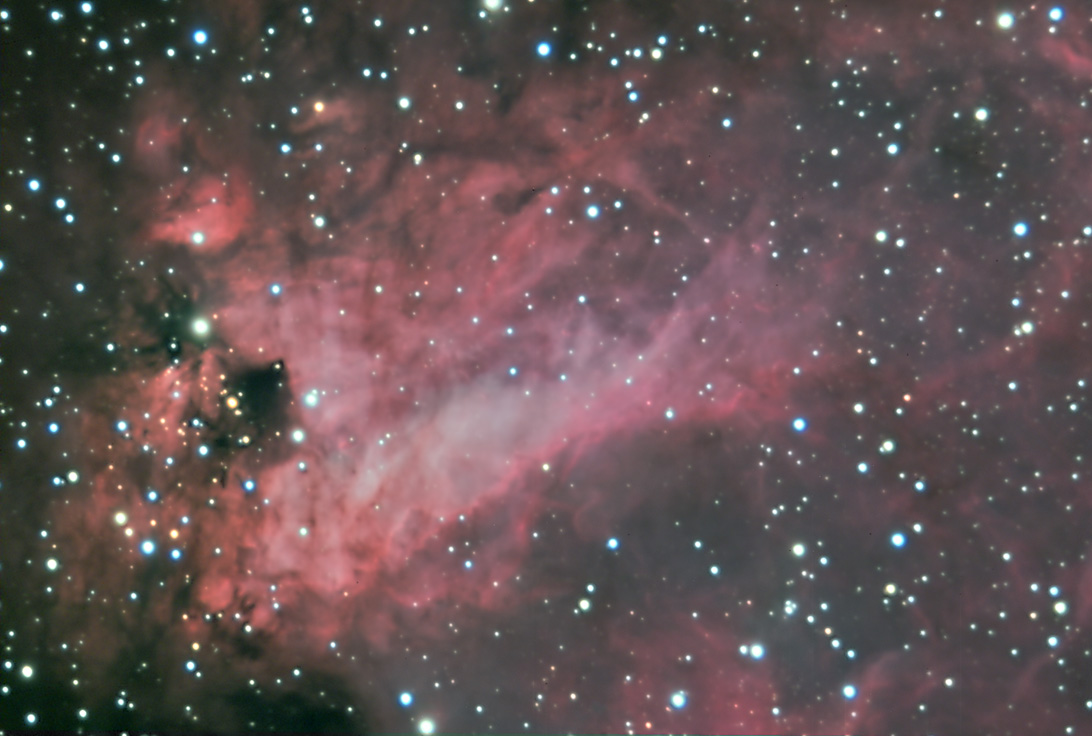M17 - Omega Nebula

For high resolution, click here.
M17 - Omega Nebula: The Omega (or Swan) nebula in the constellation Sagittarius is one of several bright emission nebulae in the direction towards the Milky Way's center. As the gas cloud collapses, the first stars to form are the very luminous, but short-lived, blue stars that light up the remaining gas with intense ultraviolet light, causing the gas to re-radiate at longer wavelengths, mostly in the H-alpha (red) color.
Messier: 17
NGC: 6618
Right Ascension: 18h 20m
Declination: -16° 10.5'
Apparent Magnitude: 6.0
Date: July 2016
Equipment:
Telescope: Meade 16" Schmidt Cassegrain with f6.3 reducer
Camera: SBIG ST-10XE
Guiding: Meade 5" refractor/DSI Pro/PHD
Exposure: L = 60x1 minute (1x1) + 17x5 minute (1x1) subframes
R:V:B = 20:26:25 in 2 minute subframes.
The camera was at -25°C.
Processing Notes: Data acquisition with CCDSoft. Reduced and aligned in CCDStack. Subs combined in Sigma Beta. RVB combined in CCDStack with a ratio of 1:1.06:1.9 (from calculations taking into account camera efficiency filter transmission and atmospheric extinction), and saved as a TIFF for import into Photoshop. Adjusted curves and levels, and added a Gaussian blur and Carboni noise reduction on the color image. Luminosity was imported directly into photoshop without a stretch. Adjusted levels and curves. Combined the dim areas from the 5 minute L image. Sharpening via unsharp mask set at several radii. Increased contrast with a high pass overlay at ~50%. Slight, faded, minimum filter to reduce star sizes. Combined with color in three layers: Luminosity on the bottom, Color on the top, and the RVB data as a "multiply" layer at ~25% in the middle.
Scale: High resolution image ~0.5"/pixel
Links to images of this object on other sites:
http://apod.nasa.gov/apod/ap021210.html
http://www.narrowbandimaging.com/m17_ap180_6303_s2hao3_page.htm
http://www.jthommes.com/Astro/DSLR/M17.htm
Additional Comments: These data were taken over several evenings by Ellie Mullin and Charles Hakes. Processing by Charles Hakes.
A previous image taken using RVB photometric filters is shown here. http://www.fortlewis.edu/observatory/image_detail.asp?ID=201 The R filter in the photometric set is significantly sensitive in IR, so many of the cooler stars show up in this image as very red stars, where they might not be seen at all with a "photographic" red filter. The other significant difference in color balance is that [OIII] is detected more in the V ("visible", or green) filter than the B, or "blue" filter.
An image taken in 2008 with a 10" LX200 is shown here. http://www.fortlewis.edu/observatory/image_detail.asp?ID=85
The 2010 data, shown as RVB only, with a slightly different color balance is here.http://www.fortlewis.edu/observatory/image_detail.asp?ID=193
Views: 3014
 This work is licensed under a Creative Commons Attribution-NonCommercial-ShareAlike 4.0 International License.
This work is licensed under a Creative Commons Attribution-NonCommercial-ShareAlike 4.0 International License.

